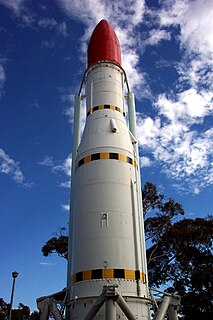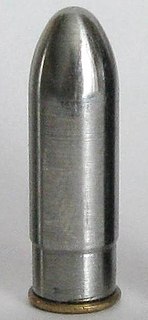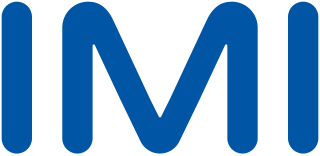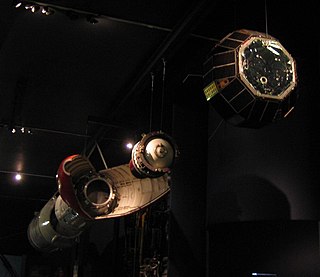Related Research Articles

A solid-propellant rocket or solid rocket is a rocket with a rocket engine that uses solid propellants (fuel/oxidizer). The earliest rockets were solid-fuel rockets powered by gunpowder; they were used in warfare by the Chinese, Persians, Mongols, and Indians as early as the 13th century.

Meteor is an active radar guided beyond-visual-range air-to-air missile (BVRAAM) developed by MBDA. Meteor offers a multi-shot capability, and has the ability to engage highly maneuverable targets, such as jets, and small targets such as UAVs and cruise missiles in a heavy electronic countermeasures (ECM) environment with a range in excess of 100 kilometres (54 nmi). A solid-fueled ramjet motor allows the missile to cruise at a speed of over Mach 4 and provides the missile with thrust and mid-course acceleration to target intercept. A two-way datalink enables the launch aircraft to provide mid-course target updates or retargeting if required, including data from off-board third parties. The datalink is capable of transmitting missile information such as functional and kinematic status, information about multiple targets, and notification of target acquisition by the seeker.

Rocketdyne was an American rocket engine design and production company headquartered in Canoga Park, in the western San Fernando Valley of suburban Los Angeles, in southern California.
DRDC Valcartier is a major Canadian military research station at Canadian Forces Base Valcartier, Quebec, one of nine centres making up Defence Research and Development Canada (DRDC).

Black Arrow, officially capitalised BLACK ARROW, was a British satellite carrier rocket. Developed during the 1960s, it was used for four launches between 1969 and 1971, all launched from the Woomera Prohibited Area in Australia. Its final flight was the first and only successful orbital launch to be conducted by the United Kingdom, and placed the Prospero satellite into low Earth orbit.

Caseless ammunition, or rather caseless cartridges, is a configuration of weapon-cartridge that eliminates the cartridge case that typically holds the primer, propellant and projectile together as a unit. Instead, the propellant and primer are fitted to the projectile in another way so that a cartridge case is not needed, for example inside or outside the projectile depending on configuration.

Titan IV was a family of heavy-lift space launch vehicles developed by Martin Marietta and operated by the United States Air Force from 1989 to 2005. Launches were conducted from Cape Canaveral Air Force Station, Florida and Vandenberg Air Force Base, California.
Blue Water was a British battlefield nuclear missile of the early 1960s, intended to replace the MGM-5 Corporal, which was becoming obsolete. With roughly the same role and range as Corporal, Blue Water was a far simpler missile that was significantly easier to support in the field. It was seen as a replacement for Corporal both in the UK as well as other NATO operators, notably Germany and possibly Turkey.
Aerojet was an American rocket and missile propulsion manufacturer based primarily in Rancho Cordova, California, with divisions in Redmond, Washington, Orange and Gainesville in Virginia, and Camden, Arkansas. Aerojet was owned by GenCorp. In 2013, Aerojet was merged by GenCorp with the former Pratt & Whitney Rocketdyne to form Aerojet Rocketdyne.

Amateur rocketry, sometimes known as experimental rocketry or amateur experimental rocketry, is a hobby in which participants experiment with fuels and make their own rocket motors, launching a wide variety of types and sizes of rockets. Amateur rocketeers have been responsible for significant research into hybrid rocket motors, and have built and flown a variety of solid, liquid, and hybrid propellant motors.

IMI plc, formerly Imperial Metal Industries, is a British-based engineering company headquartered in Birmingham, England. It is listed on the London Stock Exchange and is a constituent of the FTSE 250 Index.

The Royal Navy Propellant Factory, Caerwent is a facility at Caerwent, Monmouthshire, Wales, UK, which was dedicated to the manufacture of explosives or the storage of ammunition from 1939 to 1993.

RAF Westcott is a former Royal Air Force station located near Westcott in Buckinghamshire, England. The site fully opened in September 1942 and was the base of No.11 Operational Training Unit (OTU) flying the Vickers Wellington medium bomber until the RAF moved out in August 1945, the station was officially closed on 3 April 1946.

The Rocket Propulsion Establishment at Westcott, Buckinghamshire on the site of the former RAF Westcott has made a number of notable contributions in the field of rocket propulsion, including input on the rocket design for the Blue Streak missile and the propulsion systems on Chevaline. It was also known as the Guided Projectiles Establishment and PERME Westcott.

Waxwing was a British solid rocket motor used for apogee kick as the 3rd (upper) stage of the Black Arrow satellite launch vehicles. Waxwing was used to successfully place the Prospero X-3 satellite into low Earth orbit on 28 October 1971, Britain's only satellite launch on an indigenously developed launch vehicle.
Bristol Aerojet (BAJ) was a joint venture between the Bristol Aeroplane Company of the United Kingdom and Aerojet General of the US begun in 1959 using the existing factory at Banwell near Weston super Mare, England.

Rocket propellant is the reaction mass of a rocket. This reaction mass is ejected at the highest achievable velocity from a rocket engine to produce thrust. The energy required can either come from the propellants themselves, as with a chemical rocket, or from an external source, as with ion engines.
BATES is an acronym for BAllistic Test and Evaluation System, which is a standardized system for measuring solid rocket propellant performance designed and developed by the United States Air Force Research Laboratory in 1959 through the early 1960s, used for almost forty years thereafter, and again beginning in 2010. Then through 2016. According to this reference, a single propellant grain weighing 68 to 70 pounds was used in the original AFRL BATES motor design. An AFRL BATES propellant grain is inhibited, usually by a flame resistant cartridge case, on the OD, burning only on the two outer ends and the central bore, and is dimensioned so the burning area does not change significantly through the burn, generating a flat-topped thrust curve to minimize propellant characterization costs and simplify the data analysis.
The M549 is a High-Explosive Rocket Assisted (HERA) 155 mm howitzer round developed for use by the US Military in order to add additional range to standard howitzers, with a maximum range 30.1 km from a M198 howitzer. The projectile has two distinctive pre-assembled components—the high explosive warhead and the rocket motor, making it a form of rocket-assisted projectile. The warhead is fabricated from high fragmentation steel for increased effectiveness in terms of damage caused to target and contains a bulk-filled explosive.
Royal Ordnance Rocket Motors was a former division of Royal Ordnance, previously ICI, in Worcestershire that made small rocket motors for missiles.